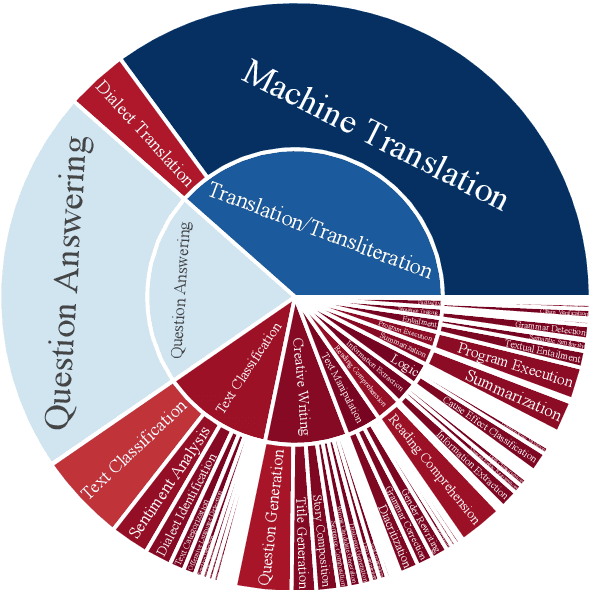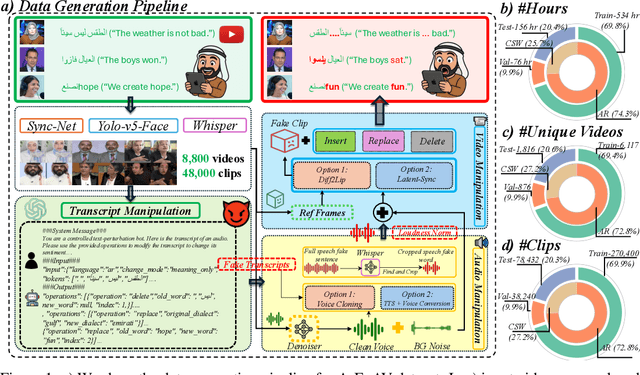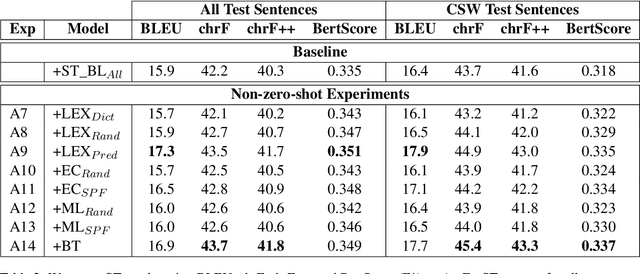Injy Hamed
CS-FLEURS: A Massively Multilingual and Code-Switched Speech Dataset
Sep 17, 2025Abstract:We present CS-FLEURS, a new dataset for developing and evaluating code-switched speech recognition and translation systems beyond high-resourced languages. CS-FLEURS consists of 4 test sets which cover in total 113 unique code-switched language pairs across 52 languages: 1) a 14 X-English language pair set with real voices reading synthetically generated code-switched sentences, 2) a 16 X-English language pair set with generative text-to-speech 3) a 60 {Arabic, Mandarin, Hindi, Spanish}-X language pair set with the generative text-to-speech, and 4) a 45 X-English lower-resourced language pair test set with concatenative text-to-speech. Besides the four test sets, CS-FLEURS also provides a training set with 128 hours of generative text-to-speech data across 16 X-English language pairs. Our hope is that CS-FLEURS helps to broaden the scope of future code-switched speech research. Dataset link: https://huggingface.co/datasets/byan/cs-fleurs.
BALSAM: A Platform for Benchmarking Arabic Large Language Models
Jul 30, 2025



Abstract:The impressive advancement of Large Language Models (LLMs) in English has not been matched across all languages. In particular, LLM performance in Arabic lags behind, due to data scarcity, linguistic diversity of Arabic and its dialects, morphological complexity, etc. Progress is further hindered by the quality of Arabic benchmarks, which typically rely on static, publicly available data, lack comprehensive task coverage, or do not provide dedicated platforms with blind test sets. This makes it challenging to measure actual progress and to mitigate data contamination. Here, we aim to bridge these gaps. In particular, we introduce BALSAM, a comprehensive, community-driven benchmark aimed at advancing Arabic LLM development and evaluation. It includes 78 NLP tasks from 14 broad categories, with 52K examples divided into 37K test and 15K development, and a centralized, transparent platform for blind evaluation. We envision BALSAM as a unifying platform that sets standards and promotes collaborative research to advance Arabic LLM capabilities.
CaMMT: Benchmarking Culturally Aware Multimodal Machine Translation
May 30, 2025



Abstract:Cultural content poses challenges for machine translation systems due to the differences in conceptualizations between cultures, where language alone may fail to convey sufficient context to capture region-specific meanings. In this work, we investigate whether images can act as cultural context in multimodal translation. We introduce CaMMT, a human-curated benchmark of over 5,800 triples of images along with parallel captions in English and regional languages. Using this dataset, we evaluate five Vision Language Models (VLMs) in text-only and text+image settings. Through automatic and human evaluations, we find that visual context generally improves translation quality, especially in handling Culturally-Specific Items (CSIs), disambiguation, and correct gender usage. By releasing CaMMT, we aim to support broader efforts in building and evaluating multimodal translation systems that are better aligned with cultural nuance and regional variation.
Tell me Habibi, is it Real or Fake?
May 28, 2025



Abstract:Deepfake generation methods are evolving fast, making fake media harder to detect and raising serious societal concerns. Most deepfake detection and dataset creation research focuses on monolingual content, often overlooking the challenges of multilingual and code-switched speech, where multiple languages are mixed within the same discourse. Code-switching, especially between Arabic and English, is common in the Arab world and is widely used in digital communication. This linguistic mixing poses extra challenges for deepfake detection, as it can confuse models trained mostly on monolingual data. To address this, we introduce \textbf{ArEnAV}, the first large-scale Arabic-English audio-visual deepfake dataset featuring intra-utterance code-switching, dialectal variation, and monolingual Arabic content. It \textbf{contains 387k videos and over 765 hours of real and fake videos}. Our dataset is generated using a novel pipeline integrating four Text-To-Speech and two lip-sync models, enabling comprehensive analysis of multilingual multimodal deepfake detection. We benchmark our dataset against existing monolingual and multilingual datasets, state-of-the-art deepfake detection models, and a human evaluation, highlighting its potential to advance deepfake research. The dataset can be accessed \href{https://huggingface.co/datasets/kartik060702/ArEnAV-Full}{here}.
The Impact of Code-switched Synthetic Data Quality is Task Dependent: Insights from MT and ASR
Mar 30, 2025



Abstract:Code-switching, the act of alternating between languages, emerged as a prevalent global phenomenon that needs to be addressed for building user-friendly language technologies. A main bottleneck in this pursuit is data scarcity, motivating research in the direction of code-switched data augmentation. However, current literature lacks comprehensive studies that enable us to understand the relation between the quality of synthetic data and improvements on NLP tasks. We extend previous research conducted in this direction on machine translation (MT) with results on automatic speech recognition (ASR) and cascaded speech translation (ST) to test generalizability of findings. Our experiments involve a wide range of augmentation techniques, covering lexical replacements, linguistic theories, and back-translation. Based on the results of MT, ASR, and ST, we draw conclusions and insights regarding the efficacy of various augmentation techniques and the impact of quality on performance.
NADI 2024: The Fifth Nuanced Arabic Dialect Identification Shared Task
Jul 06, 2024Abstract:We describe the findings of the fifth Nuanced Arabic Dialect Identification Shared Task (NADI 2024). NADI's objective is to help advance SoTA Arabic NLP by providing guidance, datasets, modeling opportunities, and standardized evaluation conditions that allow researchers to collaboratively compete on pre-specified tasks. NADI 2024 targeted both dialect identification cast as a multi-label task (Subtask~1), identification of the Arabic level of dialectness (Subtask~2), and dialect-to-MSA machine translation (Subtask~3). A total of 51 unique teams registered for the shared task, of whom 12 teams have participated (with 76 valid submissions during the test phase). Among these, three teams participated in Subtask~1, three in Subtask~2, and eight in Subtask~3. The winning teams achieved 50.57 F\textsubscript{1} on Subtask~1, 0.1403 RMSE for Subtask~2, and 20.44 BLEU in Subtask~3, respectively. Results show that Arabic dialect processing tasks such as dialect identification and machine translation remain challenging. We describe the methods employed by the participating teams and briefly offer an outlook for NADI.
CVQA: Culturally-diverse Multilingual Visual Question Answering Benchmark
Jun 10, 2024



Abstract:Visual Question Answering (VQA) is an important task in multimodal AI, and it is often used to test the ability of vision-language models to understand and reason on knowledge present in both visual and textual data. However, most of the current VQA models use datasets that are primarily focused on English and a few major world languages, with images that are typically Western-centric. While recent efforts have tried to increase the number of languages covered on VQA datasets, they still lack diversity in low-resource languages. More importantly, although these datasets often extend their linguistic range via translation or some other approaches, they usually keep images the same, resulting in narrow cultural representation. To address these limitations, we construct CVQA, a new Culturally-diverse multilingual Visual Question Answering benchmark, designed to cover a rich set of languages and cultures, where we engage native speakers and cultural experts in the data collection process. As a result, CVQA includes culturally-driven images and questions from across 28 countries on four continents, covering 26 languages with 11 scripts, providing a total of 9k questions. We then benchmark several Multimodal Large Language Models (MLLMs) on CVQA, and show that the dataset is challenging for the current state-of-the-art models. This benchmark can serve as a probing evaluation suite for assessing the cultural capability and bias of multimodal models and hopefully encourage more research efforts toward increasing cultural awareness and linguistic diversity in this field.
ZAEBUC-Spoken: A Multilingual Multidialectal Arabic-English Speech Corpus
Mar 27, 2024Abstract:We present ZAEBUC-Spoken, a multilingual multidialectal Arabic-English speech corpus. The corpus comprises twelve hours of Zoom meetings involving multiple speakers role-playing a work situation where Students brainstorm ideas for a certain topic and then discuss it with an Interlocutor. The meetings cover different topics and are divided into phases with different language setups. The corpus presents a challenging set for automatic speech recognition (ASR), including two languages (Arabic and English) with Arabic spoken in multiple variants (Modern Standard Arabic, Gulf Arabic, and Egyptian Arabic) and English used with various accents. Adding to the complexity of the corpus, there is also code-switching between these languages and dialects. As part of our work, we take inspiration from established sets of transcription guidelines to present a set of guidelines handling issues of conversational speech, code-switching and orthography of both languages. We further enrich the corpus with two layers of annotations; (1) dialectness level annotation for the portion of the corpus where mixing occurs between different variants of Arabic, and (2) automatic morphological annotations, including tokenization, lemmatization, and part-of-speech tagging.
Data Augmentation Techniques for Machine Translation of Code-Switched Texts: A Comparative Study
Oct 23, 2023



Abstract:Code-switching (CSW) text generation has been receiving increasing attention as a solution to address data scarcity. In light of this growing interest, we need more comprehensive studies comparing different augmentation approaches. In this work, we compare three popular approaches: lexical replacements, linguistic theories, and back-translation (BT), in the context of Egyptian Arabic-English CSW. We assess the effectiveness of the approaches on machine translation and the quality of augmentations through human evaluation. We show that BT and CSW predictive-based lexical replacement, being trained on CSW parallel data, perform best on both tasks. Linguistic theories and random lexical replacement prove to be effective in the lack of CSW parallel data, where both approaches achieve similar results.
Benchmarking Evaluation Metrics for Code-Switching Automatic Speech Recognition
Nov 22, 2022Abstract:Code-switching poses a number of challenges and opportunities for multilingual automatic speech recognition. In this paper, we focus on the question of robust and fair evaluation metrics. To that end, we develop a reference benchmark data set of code-switching speech recognition hypotheses with human judgments. We define clear guidelines for minimal editing of automatic hypotheses. We validate the guidelines using 4-way inter-annotator agreement. We evaluate a large number of metrics in terms of correlation with human judgments. The metrics we consider vary in terms of representation (orthographic, phonological, semantic), directness (intrinsic vs extrinsic), granularity (e.g. word, character), and similarity computation method. The highest correlation to human judgment is achieved using transliteration followed by text normalization. We release the first corpus for human acceptance of code-switching speech recognition results in dialectal Arabic/English conversation speech.
 Add to Chrome
Add to Chrome Add to Firefox
Add to Firefox Add to Edge
Add to Edge